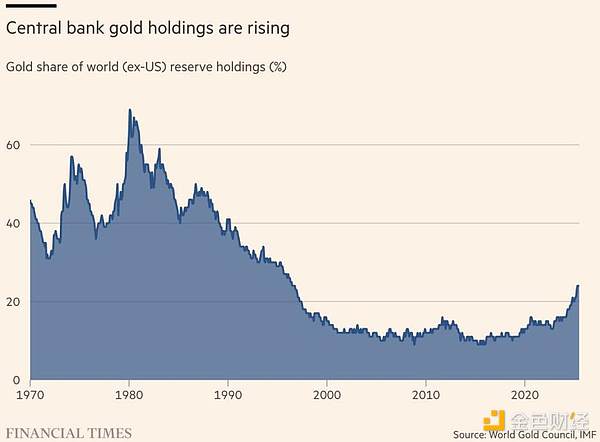Author: Anthony Pompliano, Founder and CEO of Professional Capital Management; Translation: Jinse Caijing xiaozou
As capital allocators try to make sense of the global landscape, all eyes are on gold and Bitcoin.
The market consensus in 2025 is that while gold is a high-quality asset, its offensive capabilities are weaker than its defensive capabilities—precisely Bitcoin's strength.
This decentralized asset is positioned as "digital gold," or as I've previously called it, "gold with wings." The core logic is that Bitcoin possesses the same sound monetary properties as precious metals, while also possessing unique advantages (including a limited supply, a halving mechanism, and a relatively short development history) that promise it to consistently outperform gold.
However, this expectation did not materialize in 2025.
In fact, gold has risen approximately 60% this year, its best performance in nearly half a century. Charlie Bilello, Chief Market Strategist at Creative Planning, noted: "Gold has been the best-performing major asset class over the past 20 years, with an annualized return exceeding 11%." This performance, especially in the past 11 months, has led to a significant increase in the proportion of gold held by central banks in their reserves. Charlie wrote: "Gold now accounts for over 20% of global central bank reserves, the highest share in nearly three decades."

Central bank demand is crucial because it has successfully offset the impact of the continued net selling of gold and silver by US retail investors since the sharp price increase in March 2024.
However, what confuses many investors is that Bitcoin and gold have historically had a close correlation: when gold prices rise, Bitcoin typically follows approximately 100 days later. Both asset classes benefit from macro tailwinds such as rising national debt, disorderly monetary policy, and geopolitical uncertainty. Faced with these challenges, investors tend to allocate a larger portion of their portfolios to sound money assets—those that are both outside the traditional system and inherently non-inflatable. So why has gold responded to recent global events while Bitcoin has lagged? Is it simply because central banks have ample liquidity, and since this large pool of capital hasn't yet been allocated to Bitcoin, gold prices have risen? That's partly the case. But there are more nuanced factors at play. Most people focus excessively on gold's outperformance while overlooking Bitcoin's relative weakness. Joe Carlasare points out that the current Bitcoin bull run has been far less volatile than previous ones. We haven't seen the spectacular gains we expected, suggesting a lack of a market rally driven by retail investor enthusiasm. If you bought Bitcoin for speculative purposes, especially if its seemingly asymmetric return potential was your primary attraction, you're undoubtedly feeling deeply disappointed. I completely understand that feeling—Bitcoin has certainly failed to deliver on that promise so far in this cycle. But if you view Bitcoin as a defensive asset against currency debasement and runaway inflation, you should be pleased with its performance. Bitcoin has risen approximately 1,500% since January 2020 and is projected to gain over 18% by 2025. Bitcoin's past asymmetry stemmed from the high risk investors took on. Risk and reward always go hand in hand. But Bitcoin is no longer a high-risk asset: it's clearly not going away, governments won't ban it, and it will eventually become part of every sophisticated investor's portfolio. Therefore, you should expect lower returns than in previous bull markets. This doesn't diminish its appeal; rather, it suggests its rise is inevitable. While it will take time, Bitcoin will eventually become a top global store of value. Gold and Bitcoin will develop in tandem; the two aren't competitors, but allies in the fight against currency debasement. Coexistence is good for both asset classes. In the short term, however, this past weekend may have been a turning point. We are likely to witness a large-scale rotation of funds from gold to Bitcoin before the end of the year. Joao Wedson noted: "BTC/gold ratio bottom signals are extremely rare and typically occur during periods of high volatility and sharp Bitcoin pullbacks – which is exactly what we are experiencing right now." The blue signal indicates the current bottom, with the Standardized Oscillator essentially saying, 'It's time to sell gold and buy Bitcoin.' The green signal is even stronger, occurring when both indicators hit bottom simultaneously. Historically, these moments have created the best BTC/gold allocation opportunities. To institutional gold holders, I would study this chart carefully. Bitcoin's risk-reward ratio is more attractive than it currently is, especially during this period of gold mania. Feel free to use this chart for your analysis, but remember this moment – this could be a historic turning point for both gold and Bitcoin." To sum up: Gold is poised for strong performance in 2025, but past performance is no indicator of future performance. We may be on the cusp of a major rotation from gold to Bitcoin. If this scenario plays out, Bitcoin could end the year with a spectacular rally.
 Kikyo
Kikyo
 Kikyo
Kikyo Clement
Clement Joy
Joy Hui Xin
Hui Xin YouQuan
YouQuan Clement
Clement Jixu
Jixu Jasper
Jasper Alex
Alex Hui Xin
Hui Xin